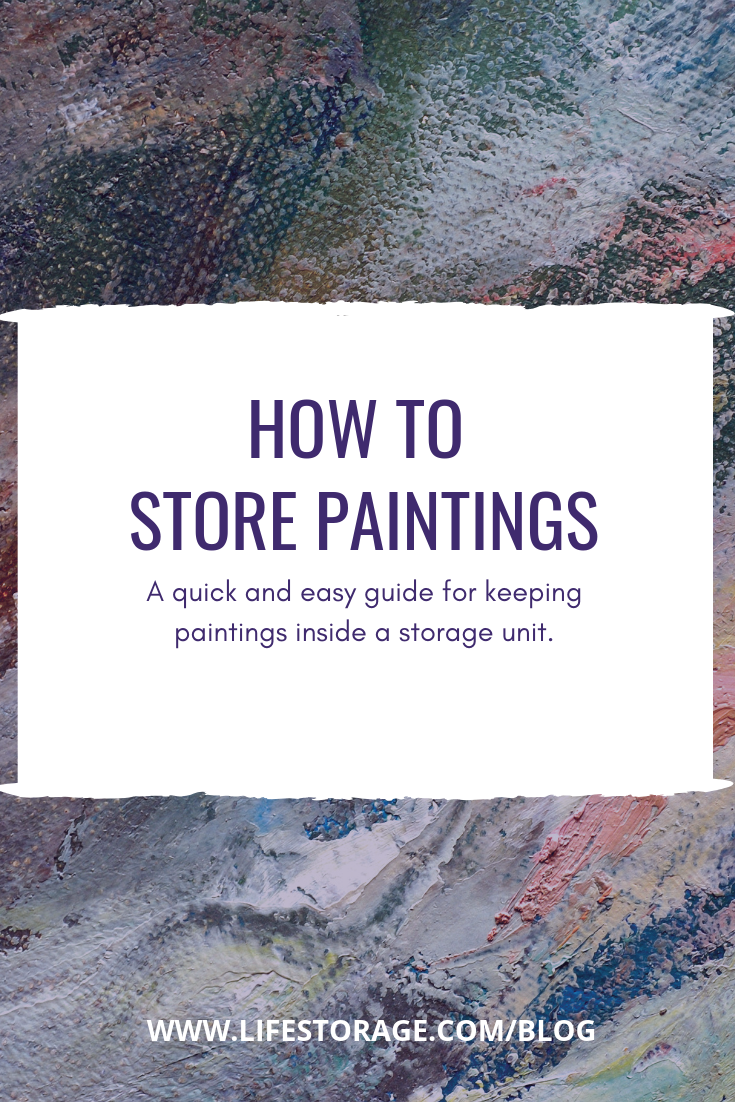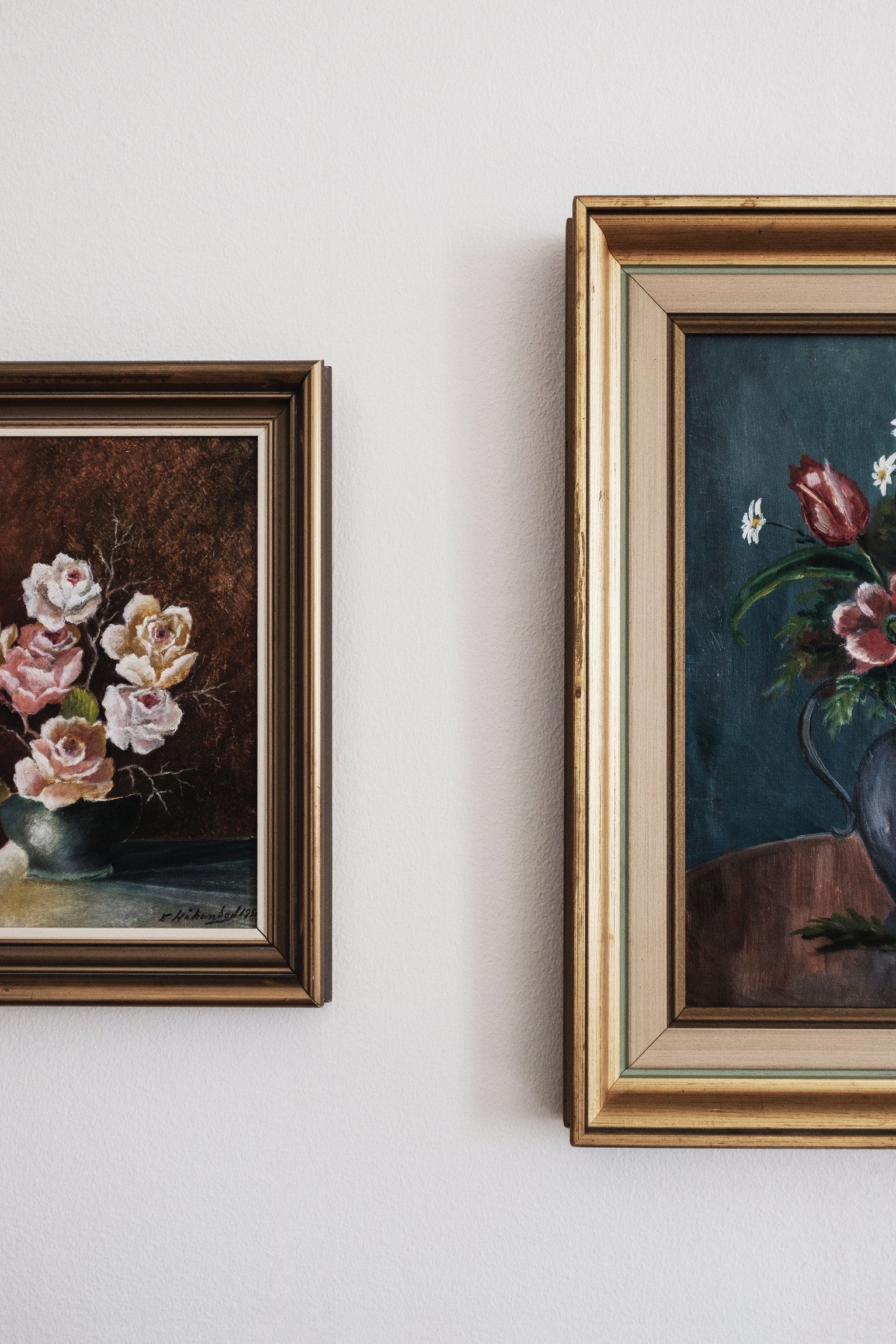
It doesn’t take an artist or a fine art connoisseur to understand that art in all forms can hold major sentimental value. Whether you purchased a colorful print on a memorable trip overseas or were gifted a beautiful painting by a close friend or family member, the artwork you choose to display in your home can be deeply personal and meaningful.
But what should you do if you’re moving into a new home, relocating your family across the country, or temporarily moving your belongings into a storage unit? How can you ensure that your paintings, prints, and other pieces of art will be safe during this transitional time?
How to Store Paintings & Artwork: A Complete Guide
Knowing how to store paintings is crucial to protecting and preserving your artwork for years to come. Someone who doesn’t know much about artwork might pack up a painting with a simple sheet of newsprint and call it a day, but we know there are safer ways to store artwork.
Storing a painting requires specific conditions to ensure that the paint, canvas, and frame don’t withstand any damage. Whether you store paintings in frames or have an extensive collection of unframed art prints, this guide will cover the do’s and don’ts of painting and artwork storage, plus helpful advice for how to store paintings without devaluing them.
Handling Works of Art: Major Risk Factors & Basic Tips
If you’re new to the world of fine art, you may not know the proper way to care for a painting or any piece of artwork at home.
And while you don’t need to automatically implement museum-level standards of care, educating yourself on the most common risk factors involved in handling paintings is the first step in learning how to protect and preserve your artwork for years to come.

According to The Conservation Register, the biggest threats to a painting or other works of fine art are:
- Breakages, tears, smudges, and impacts of any kind
- Loose and missing elements
- Fingerprints etched into polished surfaces
- Stains and marks from skin contact, eating, smoking, cosmetics and other domestic chemicals
- Introduction of materials and conditions that encourage pests or other environmental damage: foods, other infested objects, poor storage materials, central heating, damp storage conditions, intense light, or continued exposure to sunlight
The common link? People. People accidentally break, rip or spill their coffee onto their precious paintings. They put their grubby fingers all over the surface. They store their art in a convenient place, like their moldy basement.
Bottom line: Proper handling of paintings, prints, collages, and other art pieces is one of the easiest and most effective ways to prevent damage.
Related: How to Display, Repurpose, and Store Sentimental Cards
Before hanging, moving, or storing any art, always thoroughly wash your hands, be aware of your surroundings, and work as carefully as possible. For more tips on properly and safely handling your paintings at home, check out this blog post from an archival professional: Seven Basic Tips for Handling Objects and Works of Art.
How to Properly Pack Paintings for Moving & Storage
Whether you need to know how to pack a painting away for long-term storage or just need to get it from point A to point B, here are a few important things to keep in mind:

- Minimize contact. The first step to conserving oil paintings and other types of artwork during transportation or storage is to minimize human contact. This goes for all settings, including on the moving truck or van, inside your home, or in long-term storage. An easy way to accomplish this is to create a barrier between you and the painting during the packing process.
- Wrap in plastic. An easy way to protect your paintings is simply by wrapping them in a solid sheet of durable plastic. Using plastic to wrap the painting will keep it clean and protect the finish during the moving process.
- Seal with styrofoam. Once your painting is properly protected and wrapped with care, use a custom-sized styrofoam box to ensure that the painting is safe and snug. The less your art is jostled or slid around during your move, the less likely it will be damaged in the process.
- Place the styrofoam-packed painting into a tight-fitting cardboard box. If you already have an appropriately-sized painting storage box built specifically with your piece’s custom dimensions in mind, use it. If your piece of art didn’t come with a box, you could make one from a couple of good-sized sheets of cardboard and a box cutter.
- Pack with dense packing material. Make sure you fill any space in the box with bubble wrap or high-quality packing peanuts to avoid bouncing or jarring in transit. Then, seal the entire apparatus shut with packing tape. Avoid flimsy peanuts or any packing material that can get smashed or settle over time.
Related: How to Pack Moving Boxes Efficiently
How to Safely Transport a Painting While Moving
Once your artwork is secured correctly, it’s time to get moving! Here’s how to transport a painting or any piece of fine art with care:

- Be careful when driving. You should always practice safe driving on the road, especially while you’ve got precious cargo in tow. Driving carefully, taking turns slowly, and easing into stops can help make sure your painting won’t be flung around en route to your destination.
- Pack the painting vertically. This is an important detail: Be sure to stand your painting upright as you move it from one destination to another. If your painting is lying flat, something (or someone) could fall, flop, or sit on your painting.
- Cushion the painting with other objects. If you have no choice but to lay the artwork flat inside your car or moving truck, slide the painting against something solid or between two other objects in case you must stop quickly. That way, you’ll proactively minimize the opportunity for a sudden impact that could damage the art. Bringing a blanket or pillow for extra cushioning is also recommended.
- Pick a reliable carrier. Are you shipping the art through a professional carrier? Whether you are considering the United States Postal Service or a private company like FedEx or UPS, each service has unique rates, rules, and standards for shipping based on the size and weight of your parcel. You can use an online calculator to compare rates to get an idea of what you will pay.
- Insure against damage. Unfortunately, controlling every possible factor in the moving process is impossible. Especially if you’re moving cross-country or choosing to ship your painting, purchasing shipping insurance is a good idea for added protection and peace of mind.
Related: How to Choose a Moving Company
Painting Storage Tips: How Should Paintings Be Stored?
For various reasons, you may want to wait to move your paintings directly into your new home. Maybe you’re moving in with a roommate or into a college dorm and don’t have space for your art collection, or maybe you’re temporarily living with your parents to save money for a down payment on a house.
Related: What is Coliving & What Are the Benefits?
Whatever the case may be, there are a few important things to keep in mind if your paintings will be spending some time in storage before, during, or after your move:

- Never store artwork in dry or damp areas. They may be convenient for storing holiday decorations and other seasonal items, but basements and attics are not ideal for painting storage. Choose someplace with consistent temperature and moderate humidity, like a bedroom, an office, or even a climate-controlled storage unit.
- Don’t store paintings on top of each other. Remember: It’s best to store paintings in an upright position. But if you must lay your painting or paintings flat, use a rack to keep the artwork off the ground and each other. Frames and canvases can absorb dampness from concrete and other materials and can get distorted in the frame if too much weight is on top of them.
- Keep paintings away from fluctuating temperatures. If there is a furnace in your storage space or inadequate heating or cooling, the sudden changes can damage your art and even promote mold growth on canvases. Stable temperatures and low humidity levels are ideal for artwork of all kinds.
- Store paintings away from the sun. Direct sunlight can fade colors and permanently damage artwork. Keep paintings covered with an acid-free cloth or leave the artwork in its travel packaging for safekeeping.
- Don’t forget about it! Amidst the chaos of moving into a new home, it’s easy to toss your artwork into storage and promptly forget about it. Leaving paintings in storage for too long without checking in on them means that potential hazards can’t be monitored and remedied. Remember to check for signs of rodents, moisture, and other factors to make corrections as needed.
How Do You Prevent Mold on Paintings in Storage?
Paintings and other pieces of artwork can be highly susceptible to mold growth depending on where you choose to store them. Humidity levels, low lighting, and even the materials used to create the painting can all contribute to rapid mold growth if the proper precautions aren’t taken before moving your artwork into storage.
To prevent mold growth on paintings, follow the above precautions to prep your art for storage, and be sure to take the time to consider the best place to store paintings in your home. Typically, a room with good air circulation and steady humidity levels works best.
Learn more about what environment mold grows best in and how to proactively protect your paintings from mold growth by reading Stella Art Conservation’s comprehensive guide: How to Save Your Art From Mold.
Can You Store Paintings in a Storage Unit?
Planning on keeping your art in storage for an extended period of time? Consider working with professionals! Paintings can safely be kept in a storage unit if you take the necessary steps and precautions beforehand.
Modern storage units typically offer a wide variety of amenities and options to choose from, making them a decent option for storing paintings and artwork over a more extended period of time. Follow the tips above to safely pack your paintings away for storage, prevent mold growth, and more.
Looking for a storage unit near you? Life Storage can provide climate and temperature controlled storage, clean, secure units, and the peace of mind you don’t necessarily get when you keep paintings in the attic or anywhere else at home. Use our online guide to find cheap storage rentals near you.
Related: Tips for How Self Storage Works
Store Your Paintings Like a Professional
Whether you’re moving your extensive art collection into a brand new home or temporarily relocating a painting to a storage unit, it’s essential to follow proper care and handling guidelines throughout the process. Taking extra precautions while packing, storing, and transporting paintings will help save you the headache that comes with these fragile pieces getting damaged or ruined.
What are your best painting storage tips? Feel free to share with us on social media, and bookmark this article for later!
- The Benefits of Climate Controlled Storage: Do You Really Need It?
- How to Store a Car in a Storage Unit
This post originally appeared on the Life Storage blog on 4/2/15 and was revised on 2/7/19 and 11/21/22 to provide new information.







